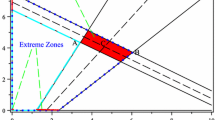Abstract
This paper presents an improved algorithm for solving the sum of linear fractional functions (SOLF) problem in 1-D and 2-D. A key subproblem to our solution is the off-line ratio query (OLRQ) problem, which asks to find the optimal values of a sequence of m linear fractional functions (called ratios), each ratio subject to a feasible domain defined by O(n) linear constraints. Based on some geometric properties and the parametric linear programming technique, we develop an algorithm that solves the OLRQ problem in O((m+n)log (m+n)) time. The OLRQ algorithm can be used to speed up every iteration of a known iterative SOLF algorithm, from O(m(m+n)) time to O((m+n)log (m+n)), in 1-D and 2-D. Implementation results of our improved 1-D and 2-D SOLF algorithm have shown that in most cases it outperforms the commonly-used approaches for the SOLF problem. We also apply our techniques to some problems in computational geometry and other areas, improving the previous results.
Similar content being viewed by others
References
E.M. Arkin, Y.-J. Chiang, M. Held, J.S.B. Mitchell, V. Sacristan, S.S. Skiena, and T.-C. Yang “On minimum-area hulls,” Algorithmica, vol. 21, pp. 119–136, 1998.
A.I. Barros Discrete and Fractional Programming Techniques for Location Models, North Holland, 1998.
D.A. Bini and G. Fiorentino “Numerical computation of polynomial roots: MPSolve-version 2.0,” FRISCO Report, 1998.
G.R. Bitran and T.L. Magnanti “Duality and sensitivity analysis for fractional programs,” OperationsResearch, vol. 24, pp. 675–699, 1976.
T.M. Chan “Deterministic algorithms for 2-d convexprogramming and 3-d online linear programming,” Journal of Algorithms, vol. 27, pp. 147–166, 1998.
R. Chandrasekaran “Minimum ratio spanning trees,”Networks, vol. 7, pp. 335–342, 1977.
B. Chazelle “On the convex layers of a planar set,” IEEE Transactions on Information Theory, vol. 31, no. 4, pp. 509–517, 1985.
D.Z. Chen, O. Daescu, X. Hu, X. Wu, and J. Xu “Determining an optimal penetration among weighted regions in two and three dimensions,” Journal of Combinatorial Optimization, for a Special Issue on Optimization Problems in Medical Applications, vol. 5, no. 1, pp. 59–79, 2001.
L. Craig, J.L. Zhou, and A.L. Tits “User’s guide for CFSQP Version 2.5,” Electrical Eng. Dept. and Institute for Systems Research, University of Maryland, TR-94-16r1, 1994.
K. Daniels “The restrict/evaluate/subdivide paradigm for translational containment,” in Proceedings of the Fifth MSI Stony Brook Workshop on Computational Geometry,1995.
H. Edelsbrunner Algorithms in Combinatorial Geometry, Springer-Verlag: New York, 1987.
H. Edelsbrunner and L.J. Guibas “Topologically sweeping an arrangement,” Journal of Computer and System Sciences, vol. 38, pp. 165–194, 1989.
D. Eppstein “Dynamic three-dimensional linear programming,” in Proceedings of 32nd Annual IEEE Symposium on Foundations of Computer Science, 1991, pp. 488–494.
J.E. Falk and S.W. Palocsay “Optimizing the sum oflinear fractional functions,” in Collection: Recent Advances in Global Optimization, C.A. Floudas and P.M. Pardalos (Eds.), 1992, pp. 221–258.
R.W. Freund and F. Jarre “Solving the sum-of-ratios problem by an interior-point method,” Journal of Global Optimization, vol. 19, no. 1, pp. 83–102, 2001.
L. Ingber Adaptive Simulated Annealing, Optimization Algorithm for Nonlinear and Stochastic Systems, http://www.ingber.com/#ASA-CODE.
M. Jelasity and J. Dombi GAS Genetic Algorithm, ftp://ftp.jate.u-szeged.hu/pub/math/optimization/GAS/.
H. Konno, T. Kuno, and Y. Yajima “Global minimization of a generalized convex multiplicative function,” Journal of Global Optimization, vol. 4, pp. 47–62, 1994.
G. Liotta, F.P. Preparata, and R. Tamassia “Robust proximity queries: An illustration of degree-driven algorithm design,” SIAM Journal on Computing, vol. 28, no. 3, pp. 864–889, 1999.
J. Majhi, R. Janardan, J. Schwerdt, M. Smid, and P. Gupta “Minimizing support structures and trapped area in two-dimensional layered manufacturing,” Technical Report TR-97-058, Dept. of Computer Science, University of Minnesota, Dec. 1997a.
J. Majhi, R. Janardan, M. Smid, and P. Gupta “On some geometric optimization problems in layered manufacturing,” in Proceedings of the 5th Workshop on Algorithms and Data Structures, vol. 1272, Springer-Verlag, 1997b, pp. 136–149.
N. Megiddo “Combinatorial optimization with rational objective functions,” Mathematics of Operations Research, vol. 4, no. 4, pp. 414–424, 1979.
N. Megiddo “Linear programming in linear time when the dimension is fixed,” Journal of ACM, vol. 31, pp. 114–127, 1984.
V. Milenkovic, K. Daniels, and Z. Li “Placement and compaction of nonconvex polygons for clothing manufacture,” in Proceedings of the 4th Canad. Conf. Comput. Geom., 1992, pp. 236–243.
F.P. Preparata and M.I. Shamos Computational Geometry: An Introduction, Springer-Verlag: New York, 1985.
T. Radzik “Newton’s method for fractional combinatorial optimization,” in Proceedings of 33rd Annual IEEE Symposium on Foundations of Computer Science, 1992, pp. 659–669.
S. Schaible “Fractional programming,” in Handbook of Global Optimization, R. Horst and P.M. Pardalos (Eds.), Kluwer Academic Publishers, 1995, pp. 495–608.
C.C. Skiscim and S. Palocsay “Minimum spanning trees with sums of ratios,” Journal of Global Optimization, vol. 19, pp. 103–120, 2001.
H. Yamashita “Efficient algorithms for minimizing the sum and the product of linear fractional functions,” Master Thesis, Dept. of Industrial Engineering and Management, Tokyo Institute of Technology, 1997.
Author information
Authors and Affiliations
Corresponding author
Additional information
This research was supported in part by the National Science Foundation under Grant CCR-9623585.
The research of this author was supported in part by National Science Foundation under grant CCF-0430366.
Grant-in-Aid of Ministry of Science, Culture and Education of Japan, No. 10780274.
The research of this author was supported in part by the Ministry of Education, Science, Sports and Culture, Grant-in-Aid for Scientific Researchon Priority Areas
Rights and permissions
About this article
Cite this article
Chen, D.Z., Daescu, O., Dai, Y. et al. Efficient Algorithms and Implementations for Optimizing the Sum of Linear Fractional Functions, with Applications. J Comb Optim 9, 69–90 (2005). https://doi.org/10.1007/s10878-005-5485-2
Received:
Revised:
Accepted:
Issue Date:
DOI: https://doi.org/10.1007/s10878-005-5485-2




